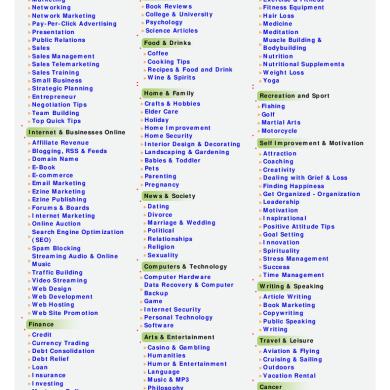* The preview only shows a few pages of manuals at random. You can get the complete content by filling out the form below.
Description
Basic Components: 1. Decision making- this includes the stages of decision making: Need recognition, Information search, Evaluation of alternatives, Purchase activity, Post purchase behavior. Cognitive & Affect 2. Actual purchase- -this includes the visible physical activity of buying of goods and/or service. It is the result of the interplay of many individual and environmental determinants which are invisible. Behaviour
3. Individual determinants and environmental influences: The environmental factors affect the decision process indirectly, through way of affecting individual determinants. 4. Buying roles: Initiator, Influencer, Decider, User, Buyer
Different Views on Customer 1. Economic and Passive Customer: buys rationally to maximize the utility – basically submissive to the self-serving interest 2. Cognitive Versus Emotional Customer: a thinker and problem solver – deeply rooted feeling and emotions
3. Potential and Realised Customer: a) non consumers b)potential consumers and c) realized consumers 4. Personal Consumer Versus Organisational Consumer
Different Views on Customer 1. Economic and Passive Customer: buys rationally to maximize the utility – basically submissive to the self-serving interest 2. Cognitive Versus Emotional Customer: a thinker and problem solver – deeply rooted feeling and emotions
3. Potential and Realised Customer: a) non consumers b)potential consumers and c) realized consumers 4. Personal Consumer Versus Organisational Consumer
Consumer Behaviour Models
Figure 6-1:
Model of Buyer Behavior
Model of Consumer Behavior by Henry Assael Feedback To Consumer Th e Co Ind ns ivi um du er al
En vi In ron flu m en en ce tal s
De Co cis ns io um n M er ak in g
Feedback to Environment Development of Marketing Strategies
Consumer Response
SOURCES OF EXTERNAL INFLUENCES ON CONSUMER BEHAVIOUR-Wilkie (1990) SCOPE – reach of the impact STRENGTH- the power to impact behaviour IMMEDIACY – direct or focused influence on behaviour; the impact is felt with no or little influence coming into play.
SCOPE
STRENGTH
IMMEDIACY
CULTURE
general
High
Long-term
SUBCULTURE
general
High
Long-term
FAMILY
specific
High
Long-term
FRIENDS
specific
High/low
CULTURE
MARKET STIMULI
specific
low
Long term/short term
The Engel-Kollat-Blackwell (EKB) model.
• First developed in 1968. • A key feature of the EKB model is the differences between high and low involvement as part of the buying process. • High involvement is present in the high risk purchase • Low involvement is present in the low risk purchase.
Consumers may perceive different types of risks in buying
Functional Risk: product performance Physical Risk: health related hazards Financial Risk: worth for the price paid Social Risk: status, embarrassments
EKB model • Consumers are seen as active agents following rules of behaviour, fairly easy to follow and implement because they require only a limited amount of information and capability of elaboration
• For instance, a consumer, being aware of a certain need and believing a certain good category satisfies it, might fix a maximum price he/she can afford and search for the best good available under such a constraint.
Main focus is Evaluation of pre-fixed parameters These parameters are fixed due to exposure to marketing controlled and non-marketing controlled stimuli
Extensive Problem Solving - initiated by the motive that is fairly central to the self-concept and the decision is perceived to carry a fair degree of risk.
Limited Problem Solving - involves recognizing a problem for which there are several solutions. There is limited amount of external search, simple decision rules are followed on a few attributes and a little post-purchase evaluation is required
Routine Response Behaviour - When a consumer buys a brand
Marketing Controlled Stimuli and information process
Promotion Mix Exposure - to different media platforms Attention - whatever is of interest Comprehension - own understanding Acceptance - belief Retention - recall and recognition
MEMORY
Decisional variables Beliefs- knowledge and inferences Motives - drive to satisfy need Attitudes - predisposition to respond Lifestyles- way one lives Intention - commitment, plan or decision Evaluation criteria - perceived value dimensions Normative Compliance - conforming to set rules
External Factors Culture - shared set of values beliefs and artefacts Social Class - Enduring divisions in the society Reference group - group or individual serving as point of comparison Family - people connected by blood Adoption or marriage Unexpected Circumstances
Howard & Sheth model • The model claims that a person’s purchase decision is often influenced by more than one individuals. • A family buying decision involves multiple influences from its members. • This theory shows the concept of role structure, that is individual members of the family takes on roles such as collecting information, deciding on the information budget, etc.
• The theory also states that retailers /businesses are not only dealing with a homogeneous unit but a collection of individuals with different goals, needs, motives and interests. • According to the model, the 'inputs' (stimuli) that the consumer receives from his or her environment are: 1.significative - the 'real' (physical) aspects of the product or service (which the company makes use of)
2. symbolic - the ideas or images attached by an organization (for example by advertising) 3. social - the ideas or images attached to the product or service by 'society' (for example, by reference groups) The 'outputs' are the consumer's actions, as observable results of the input stimuli. Between the inputs and outputs are the 'constructs', the processes which the consumer goes through to decide upon his or her actions.
• Howard and Sheth group these 'constructs into two areas: 1. perceptual - those concerned with obtaining and handling information about the product or service Stimulus Ambiguity Perceptual Bias
2. learning - the processes of learning that leads to the decision itself Motive Choice Confidence
Attitude Intention Brand Comprehension
Nicosia Model • This model explains the consumer behaviour by establishing a link between the organization and its prospective customers. • It analyses human being as a system with stimuli as the input to the system and the human behaviour as an output of the system. • The model suggests that message influences the predisposition of the consumer towards the product or services.
• Based on the situation, the consumer will have a certain attitude towards the product. • May result in search for the product or an evaluation of the product attributes by the consumers. • If the consumer is satisfied with the above and it may result in a positive response, with a decision to buy the product otherwise the reverse may occur.
• The model is based on four fields. • Field one – the consumer attributes and the firms’ attribute. The advertisements/messages sent from the company will reach the consumer attributes. • Sub field one is the firm’s attributes and the attributes of the product. • The sub field two is the predisposition of the consumer and his own characteristics and attributes, which are affected by his exposure to various information and message, and is responsible for the building of attitude of the consumer.
• Field two – it is related to the search and evaluation, undertaken by the consumer of the advertised product and also to verify if other alternatives are available. • It is the pre action field, where the consumer goes on for research and evaluation and gets motivated to buy the product. • It highlights the means and end relationship.
• Field three – it explains how the consumer actually buys the product. • It is the act of purchase or the decision-making to buy the product. • The customer buys the product and uses it. • Field four – it is related to the uses of the purchased items. It can also be related to an output to receive feedback on sales results by organization.
• It highlights the post-purchase behaviour and the use of the product, its storage and consumption. • The feedback from field four is fed into the firms attributes or field one, and the feedback from the experience is responsible for changing the pre-disposition of the consumer and later his attitude towards the product. • Nicosia Model is a comprehensive model of dealing with all aspects of building attitudes, purchase and use of product including the post-purchase behaviour of the consumer.













